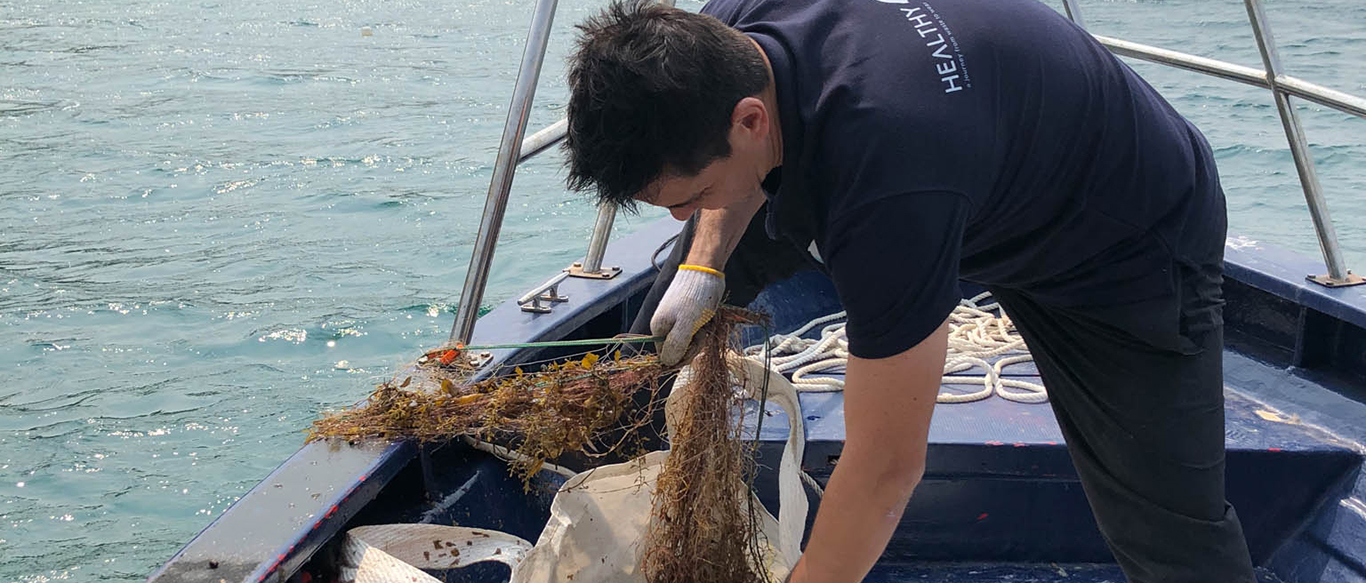Healthy Seas joins hands with Ghost Diving Hong Kong to remove gill nets
In conjunction with World Water Day, Healthy Seas is proud to announce it has expanded its geographic focus and launches activities to Hong Kong.
Healthy Seas is an environmental nonprofit organization founded in 2013 that began its marine conservation work in the Netherlands. Today, the organization operates in 20 countries throughout the world, including many countries in Europe, the United States, New Zealand and through its recent collaboration with Ghost Diving Korea and now Ghost Diving Hong Kong, has expanded to Asia, in the Sai Kung Area – Port Shelter, Nine Pins Island Group, East Dam with regular ghost net cleanup projects.
Ghost net removal
On March 18th, the Ghost Diving Hong Kong volunteer team kicked off its collaboration with Healthy Seas and with support from DWS Group, successfully recovered about 120kgs of gill nets in the area of Sharp Island, Hap Mun Bay, Sai Kung. Although gill nets are typically very light, they are also the deadliest type of marine litter to marine animals. Recently, the volunteers had recovered another 150 meters of net from the same location, while a third dive will be necessary and planned in the upcoming period to remove the nets that are still left underwater and continuing to threaten marine life. “We are extremely proud to be working with Healthy Seas and the Ghost Diving Foundation in order to remove these nets and through our work we hope to spread the message and educate the Hong Kong community to the important role we all share to remove marine pollution, not just ghost gear but debris of all forms,” says Andrew Couch, Coordinator of Ghost Diving Hong Kong.
The ghost fishing problem
It is estimated that 640,000 tons of fishing gear are lost or abandoned in the seas and oceans each year. It is plastic waste that does not biodegrade, remaining hundreds of years in the environment, all the while losing tiny particles called microplastics that end up in the food chain. The phenomenon takes the name “ghost fishing” because the nets that are made to appear invisible underwater are trapping and killing all manner of marine animals including turtles, fish, mammals and birds that get entangled, suffer and eventually die.
Fishing practices & trawling ban in Hong Kong
Capture fishing and aquaculture have a long history in Hong Kong, with the conservation of the environment and the well being of the fishing industry being at the forefront of the Hong Kong government’s agenda. Over the past few years, there has been a proactive approach to promote the conservation and preservation of Hong Kong’s marine habitat.
Since December 2012, there has been a ban on trawling within Hong Kong coastal waters to try to restore the damaged seabed. Combined with the Fisheries Protection Ordinance which is designed to regulate the size of local fishing vessels, these efforts aim at controlling fishing practices that resulted in the depletion and destruction of Hong Kong’s marine biodiversity.
Despite the efforts that have been made to conserve Hong Kong’s marine environment, there still remain challenges for the protection of the sea and coastline surrounding Hong Kong. For example, the numerous small speed boats that operate daily and deploy fine gill nets often for hundreds of meters along the sea floor. These are often lost or discarded becoming a major hazard to all marine life as well as the divers who enjoy Hong Kong’s waters. Volunteer divers also encounter the remains of nets from the trawlers that were lost or abandoned long ago and caught on submerged rocks and reefs (both natural and artificial) and aim to remove them from the ocean floor.

